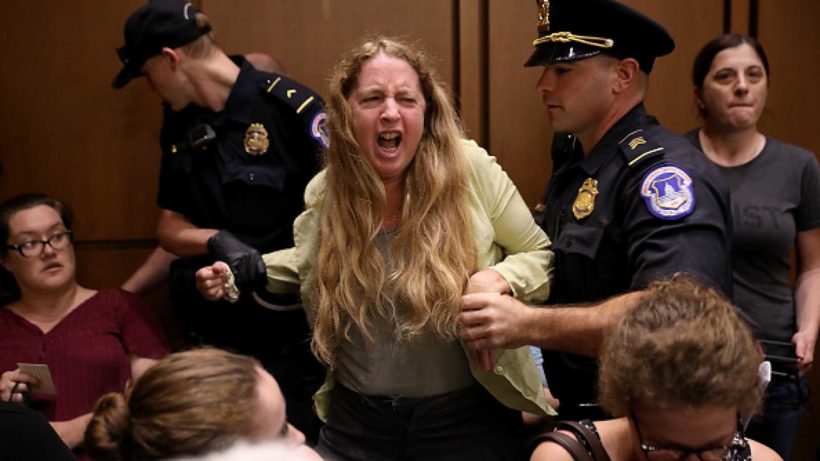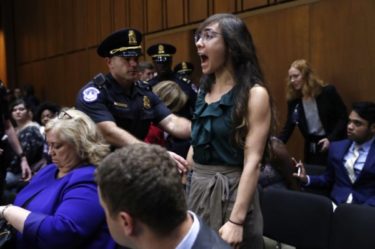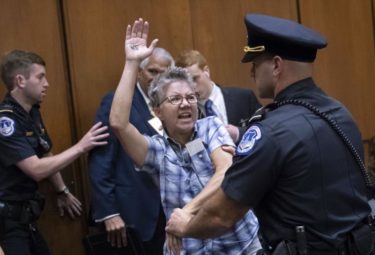
A protester during Supreme Court nominee Judge Brett Kavanaugh's confirmation hearing is removed by security Tuesday.
print Print...
(Nathan Bomey, USA Today) – A coalition of groups opposing Brett Kavanaugh’s Supreme Court nomination urged protesters to travel from throughout the U.S. to disrupt his Senate confirmation hearings this week…
Capitol police arrested 70 people for outbursts and disruptions during Kavanaugh’s hearing Tuesday – and the protests continued during his testimony Wednesday.
The protests were so frequent at times that Wednesday’s hearing assumed a decidedly halting cadence as Republican senators expressed frustration at the interruptions. On Wednesday, police temporarily closed off the hearing from additional spectators at one point, leaving some seats empty.
Protest organizers [claimed] their intentionally disruptive strategy [is] vital to preserving civil rights and democracy. They described Kavanaugh’s views on women’s rights, LGBT rights and health care as extreme and decried Trump’s authority to nominate him.
“The protests are not normal, but these are not normal times,” said Jennifer Epps-Addison, network president and co-executive director of the Center for Popular Democracy Action, which helped coordinate the protests. “These women are standing up because they know that if they’re quiet now and they allow these rigged, shamed hearings to proceed, their lives are going to be impacted in the future.”
She acknowledged that “the tactic of direct and sustained protests hasn’t been seen in these types of hearings before.”
But she said the protesters were prepared to continue as long as the Kavanaugh hearings do…
Soon after the Kavanaugh hearings were scheduled, the Center for Popular Democracy Action worked with other advocacy groups, including the pro-abortion progressive groups Women’s March, Ultraviolet and NARAL, to urge supporters to flood the capital, Epps-Addison said.
“Once we knew the hearings were going to happen, we started putting out a call through our networks, and regular folks who know the impact this will have on their lives started raising their hands and saying, ‘I’m coming,'” Epps-Addison said. “We’ve had people carpooling and caravanning to get here.”
Rachel O’Leary Carmona, chief operating officer of the Women’s March, confirmed that her group had coordinated a plan to disrupt the hearings. That included offering lodging to traveling protesters and “jail and bail support” if necessary.
“Folks realize we’re at an inflection point as a country,” she said. “The disruptions will continue all week, and the escalated tactics, as it pertains to this hearing, are not an isolated incident.”
Republicans have called Kavanaugh an experienced jurist, a reasonable person and a good man worthy of confirmation. They blasted the disruptive protests as inappropriate.
…Sen. John Cornyn, R-Texas, compared the slew of protesters to “mob rule,” describing it as “pandemonium” that’s “unlike anything I’ve seen before in a confirmation hearing.”
Amanda Thayer, deputy national communications at NARAL, said her group “has not coordinated any of the arrests happening in the hearing room.”
But she said the protests reflect a “roomful of people unified under this understanding that the rights that we hold dear are under grave threat right now with this nomination.”
Epps-Addison of the Center for Popular Democracy Action was among the protesters dragged out of Tuesday’s hearing, which she called a “sham.”
“I was the second woman who stood up and spoke my piece,” she said. “I was very, very brief. I asked the senators to be heroes – to help save our democracy and to vote no on Kavanaugh before I was tackled to the ground by four officers.”
The protesters were given tickets but had braced for worse, Epps-Addison said.
“Everybody who took an arrest yesterday was prepared to take a federal charge for disrupting a Senate hearing,” she said. “We knew the risks going in, but we knew that this was a moment that we had to stand up.”
Other groups also have garnered attention for their protests, including silent protests and other sensational rallies.
Liberal advocacy organization Demand Justice organized a group of women dressed as handmaids from the television show “The Handmaid’s Tale” to stand quietly in the hallway, signifying their belief that Kavanaugh’s appointment would suppress women’s reproductive rights.
“Despite what the Trump administration would have us believe, this country does NOT want to turn back the clock on our basic freedoms,” Demand Justice said in a Facebook event notice coordinating another protest on the Capitol lawn. “We’re going to make sure our senators hear us.”
From USAToday .com. Reprinted here for educational purposes only. May not be reproduced on other websites without permission from USAToday.
Questions
1. The first paragraph of a news article should answer the questions who, what, where and when. List the who, what, where and when of this news item. (NOTE: The remainder of a news article provides details on the why and/or how.)
2. a) How many protesters have been arrested for disrupting Brett Kavanaugh’s Senate confirmation hearings?
b) Why did police have to temporarily block more spectators from viewing the hearings on Wednesday?
3. What is the protesters’ reason for continually disrupting the hearings? – Why do they want to shut down Kavanaugh’s Senate confirmation hearings?
4. How did Jennifer Epps, head of the liberal Center for Popular Democracy Action, explain the protests?
5. What do you think is the goal of the protesters?
6. a) What is the purpose of Senate confirmation hearings for potential federal judges?
b) Do you think the Senators should vote against Kavanaugh based on these protesters’ opposition?
c) How should protesters be addressed? Allow them to continue? Bar them from attending? …
7. President Obama nominated and the Senate confirmed two Supreme Court Justices – Sonia Sotomayor and Elena Kagan. Conservatives opposed the nomination of these two judges, but they did not shout down, disrupt, and otherwise impede the confirmation process. Why do you think conservatives do not use tactics to disrupt, break up, shut down, silence people/ideas with whom they disagree?
8. In order to form your own opinion on this issue, you must understand what the controversy over the nomination of a Supreme Court Justice is all about. Read the following three paragraphs that explain the difference in the opposing views on the role of a judge, as well as the “Background” below the questions:
- The term “judicial restraint” refers to the idea that the role of a judge is not to make policy or establish new legal rights, but to interpret the law as written in the United States Constitution or in statutes passed by the legislature. Because the will of the people is best expressed through legislative bodies, judges must strive to adhere to the law as written even if, at times, the law is insufficient to deal with certain circumstances or conflicts with the judge’s personal political views.
- “Judicial activism,” by contrast, refers to results-oriented judging, whereby a judge decides the outcome of a case based not on the law as written, but on his or her conception of what is just or fair. “Judicial activism” is often improperly confused with the power of “judicial review,” which is the power of the judiciary to invalidate statutes that are in conflict with the United States Constitution.
- Although the term “judicial restraint” is often associated with political conservatism, and “judicial activism” often associated with political liberalism, they are not properly categorized as such. “Judicial restraint” and “judicial activism” refer to the process or method a judge uses to reach a particular decision, not to the political ramifications of that decision. Political liberals and political conservatives are, at least theoretically, equally capable of exercising restraint on the bench. By the same token, judicial activists may use their authority to achieve either conservative or liberal results. As such, the terms “judicial restraint” and “judicial activism” are neither inherently “conservative” nor inherently “liberal.”
From “A Primer on Judicial Restraint…” found at JudicialNetwork
Think about the role of a judge. Do you support the nomination of judges that practice judicial restrain or judicial activism? Explain your answer.
9. Read the Background and watch the videos under “Resources.” What type of judge is Brett Kavanaugh? Do you think he would make a good Supreme Court justice? Why or why not? Explain your answer.
10. a) What two adjectives would you use to describe the protesters? Explain your answers.
b) What two adjectives would you use to describe Judge Kavanaugh? Explain your answers.
c) What two adjectives would you use to describe the Democratic senators and the Republican senators in the hearings? Explain your answers.
Resources
Watch a clip from Brett Kavanaugh’s address to the Senate confirmation committee:
The following is an excerpt from Mr. Kavanaugh’s comments:
…For twelve years, I have been a judge on the U.S. Court of Appeals for the D.C. Circuit. I have written more than 300 opinions and handled more than 2,000 cases. I have given it my all in every case. I am proud of that body of work, and I stand behind it. I tell people, “Don’t read what others say about my judicial opinions. Read the opinions.” I have served with 17 other judges, each of them a colleague and a friend, on a court now led by our superb chief judge, Merrick Garland. My judicial philosophy is straightforward. A judge must be independent and must interpret the law, not make the law. A judge must interpret statutes as written. A judge must interpret the Constitution as written, informed by history and tradition and precedent. In deciding cases, a judge must always keep in mind what Alexander Hamilton said in Federalist 83: “the rules of legal interpretation are rules of common sense.”
A good judge must be an umpire—a neutral and impartial arbiter who favors no litigant or policy. As Justice Kennedy explained in Texas versus Johnson, one of his greatest opinions, judges do not make decisions to reach a preferred result. Judges make decisions because “the law and the Constitution, as we see them, compel the result.” Over the past 12 years, I have ruled sometimes for the prosecution and sometimes for criminal defendants, sometimes for workers and sometimes for businesses, sometimes for environmentalists and sometimes for coal miners. In each case, I have followed the law. I don’t decide cases based on personal or policy preferences. I am not a pro-plaintiff or pro-defendant judge. I am not a pro-prosecution or pro-defense judge. I am a pro-law judge.
As Justice Kennedy showed us, a judge must be independent, not swayed by public pressure. Our independent Judiciary is the crown jewel of our constitutional republic. In our independent Judiciary, the Supreme Court is the last line of defense for the separation of powers, and the rights and liberties guaranteed by the Constitution.
The Supreme Court must never be viewed as a partisan institution. The Justices on the Supreme Court do not sit on opposite sides of an aisle. They do not caucus in separate rooms. If confirmed to the Court, I would be part of a Team of Nine, committed to deciding cases according to the Constitution and laws of the United States. I would always strive to be a team player on the Team of Nine. … (Brett Kavanaugh, U.S. Supreme Court nominee, Sept. 5, 2018)
Compare this with the childish disruptive shouting of protestors who continuously disrupted the proceedings:
Daily “Answers” emails are provided for Daily News Articles, Tuesday’s World Events and Friday’s News Quiz.






